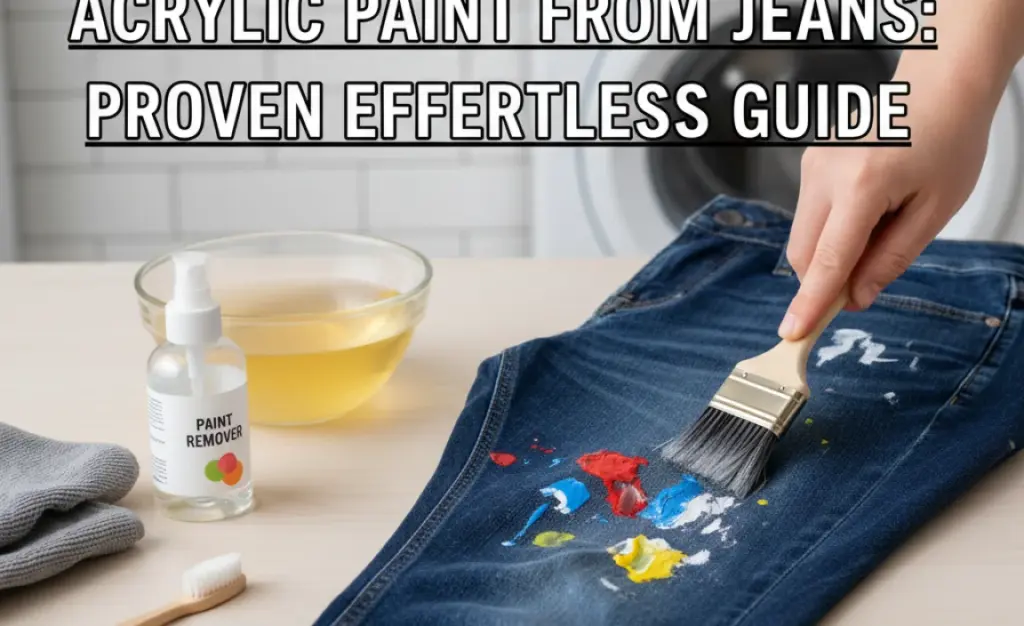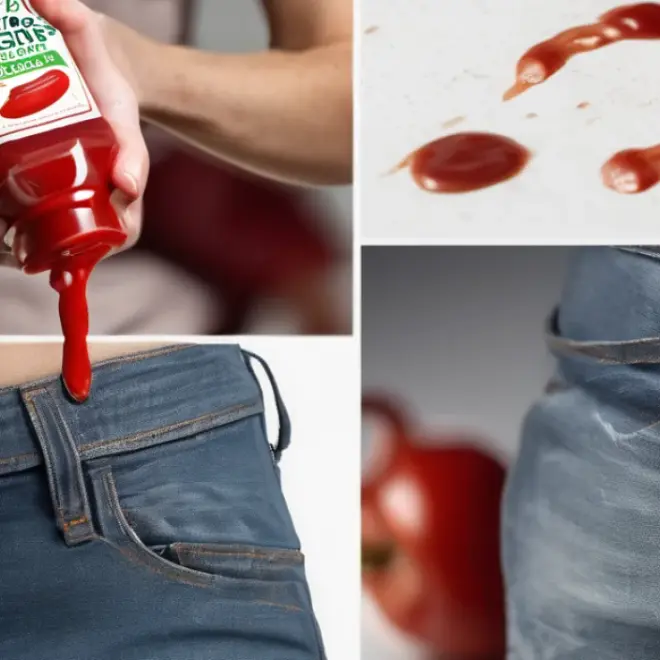Quick Summary: Don’t let acrylic paint on your favorite jeans ruin them! You can effectively remove acrylic paint from denim by acting quickly. Start with scraping off excess paint, then use a gentle solvent like rubbing alcohol or a specialized stain remover, followed by a thorough wash. With the right steps, your jeans can look good as new.
Accidentally Splashed Acrylic Paint on Your Jeans? Here’s How to Save Them!
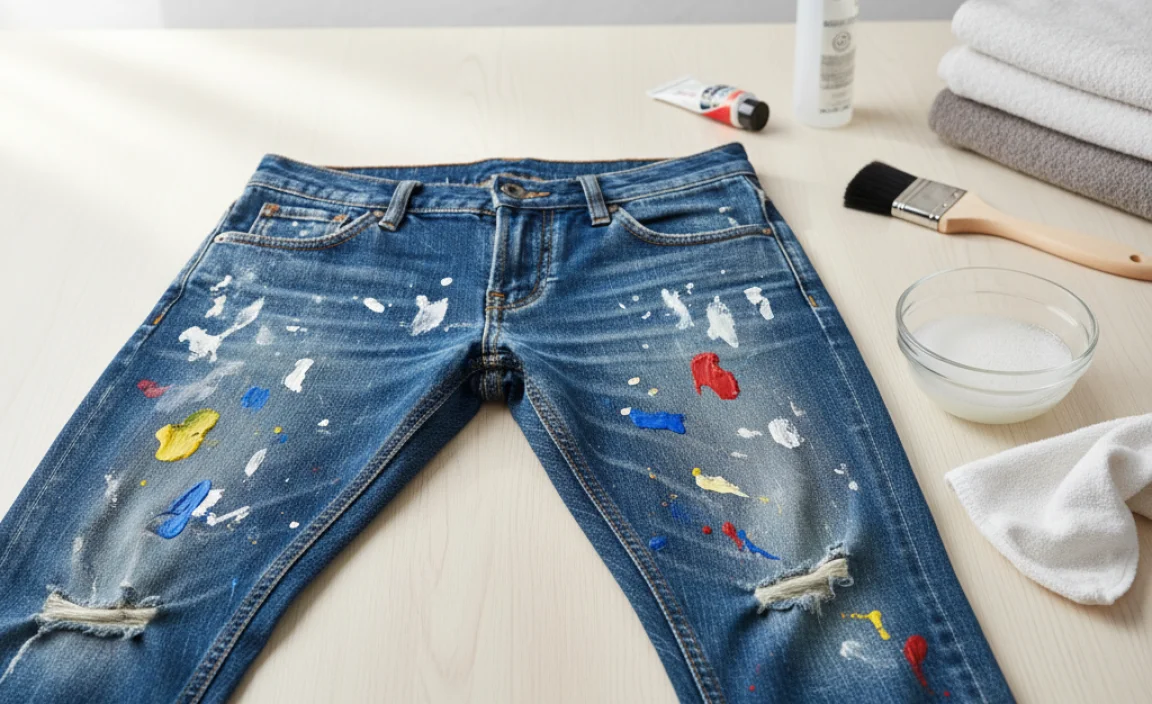
We’ve all been there. You’re working on a creative project, perhaps painting a sign or touching up some furniture, and a little splatter lands right on your favorite pair of jeans. Panic might set in, especially with stubborn acrylic paint. But don’t worry! Acrylic paint, while durable once dry, can often be removed from fabric if you tackle it correctly and promptly. This guide will walk you through simple, proven methods to rescue your denim. We’ll cover everything from what to do immediately after the spill to more stubborn, dried paint situations. Get ready to restore your jeans to their former glory!
Why Acrylic Paint is Tricky (and How to Beat It)
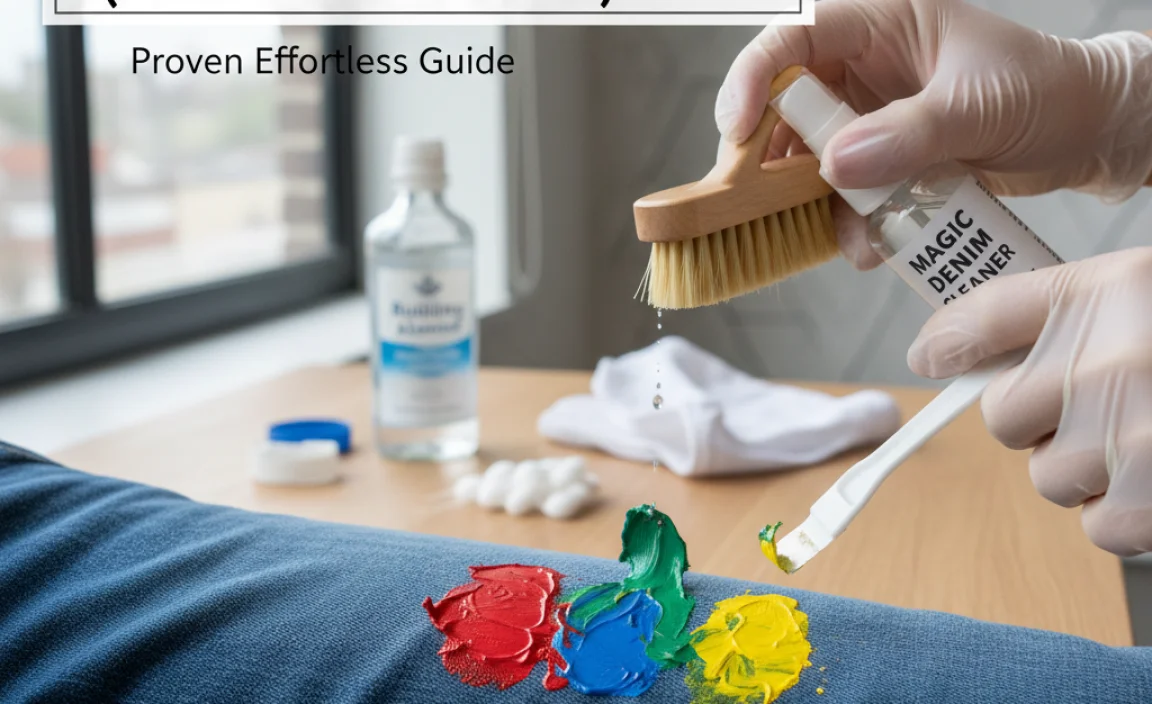
Acrylic paint is a water-based paint that becomes water-resistant and quite durable once it dries. This means it binds very effectively to fabric fibers, making older or dried stains a bit more challenging than wet ones. However, the “water-based” aspect is also its Achilles’ heel. Many common household items and specialized cleaners can break down the acrylic binder. The key is to understand the paint’s properties and employ the right techniques at the right time. Speed is your best friend when dealing with fresh paint spills!
Immediate Action: Dealing with Fresh Acrylic Paint
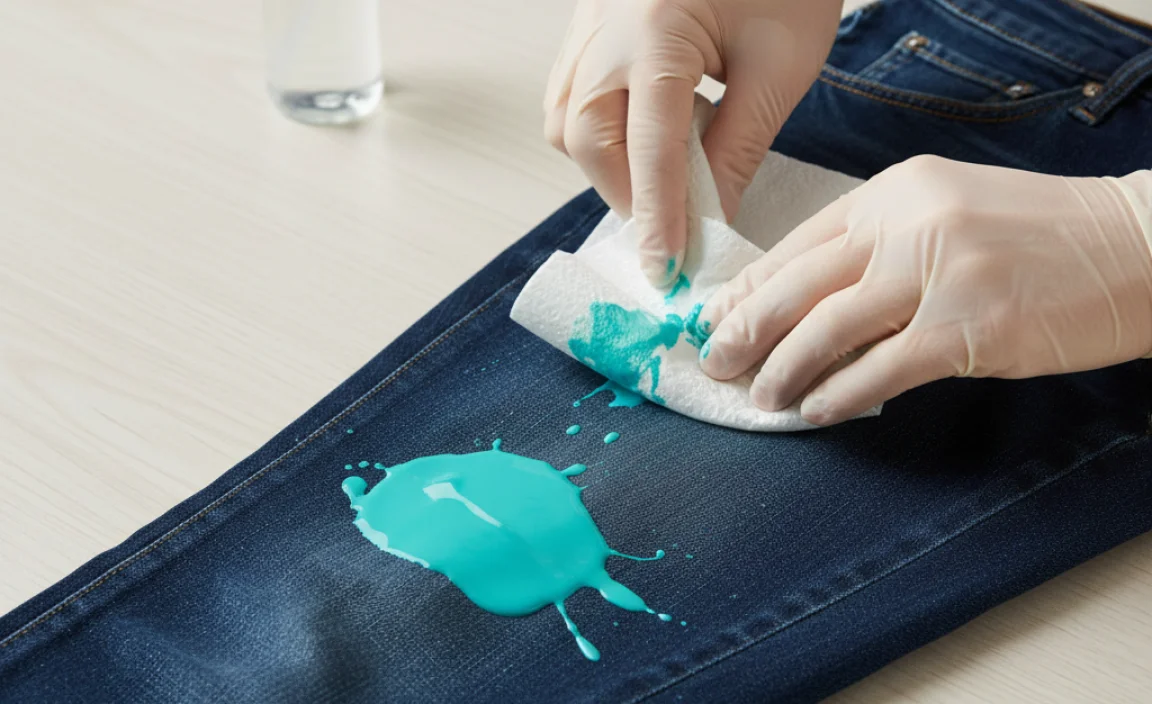
The moment you notice acrylic paint on your jeans, act fast! Fresh paint is significantly easier to remove. Here’s what you should do:
- Don’t Rub! Resist the urge to wipe or rub the paint. This will only push it deeper into the fabric fibers and spread the stain.
- Scrape Off Excess Paint: Use a dull knife, the edge of a spoon, a credit card, or even your fingernail to gently lift as much wet paint as possible from the surface of the jeans. Work from the outside of the stain inward to avoid spreading it.
- Blot the Area: Place a clean cloth or paper towel directly on the paint spot. Gently blot to absorb any remaining wet paint. Keep moving to a clean section of the cloth as it picks up paint.
- Rinse with Cold Water (if possible): If you can get to a sink quickly, turn the jeans inside out and rinse the stained area with cold water. This helps push the paint out of the fibers from the back. Avoid hot water, as it can set the stain.
What You’ll Need: Your Arsenal Against Acrylic Paint
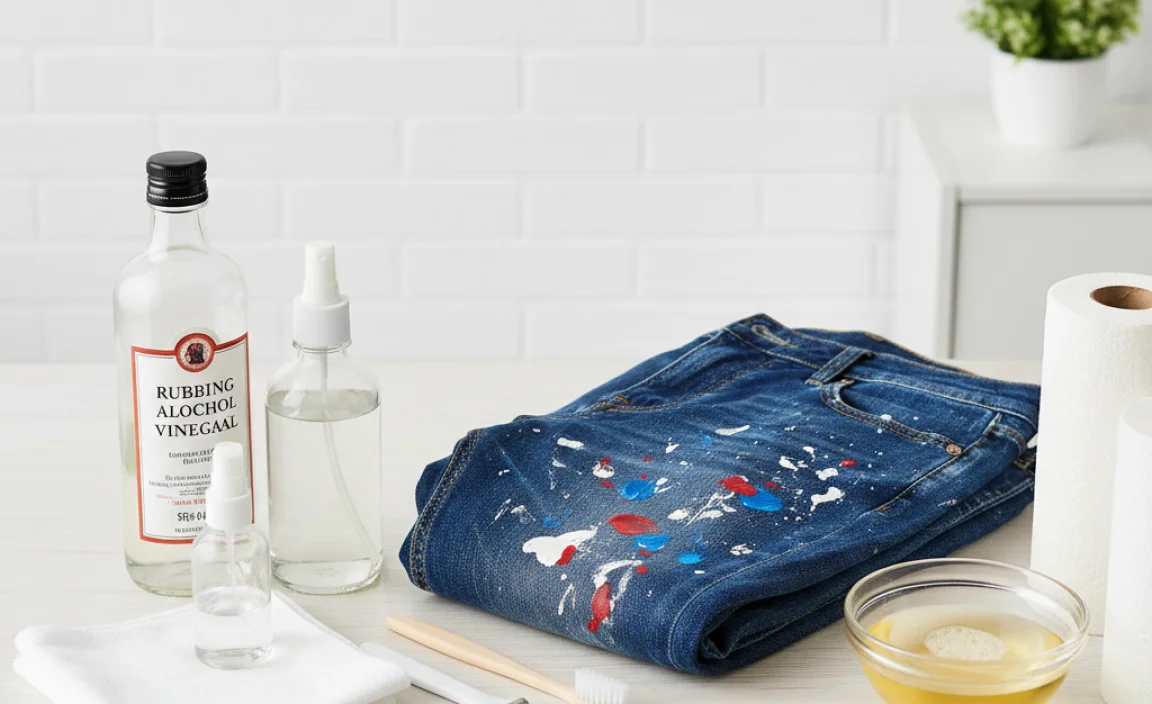
Having these items on hand will make your paint removal mission much smoother. You likely have many of them already!
- Dull knife, spoon, or credit card for scraping
- Clean cloths or paper towels
- Cold water
- Rubbing alcohol (isopropyl alcohol)
- Dish soap (mild, like Palmolive or Dawn)
- Glycerine (optional, but helpful for softening dried paint)
- Commercial stain remover (suitable for acrylics)
- Old toothbrush or soft scrub brush
- Gloves (to protect your hands)
Method 1: The Rubbing Alcohol Rescue (Best for Fresh to Moderately Dried Paint)
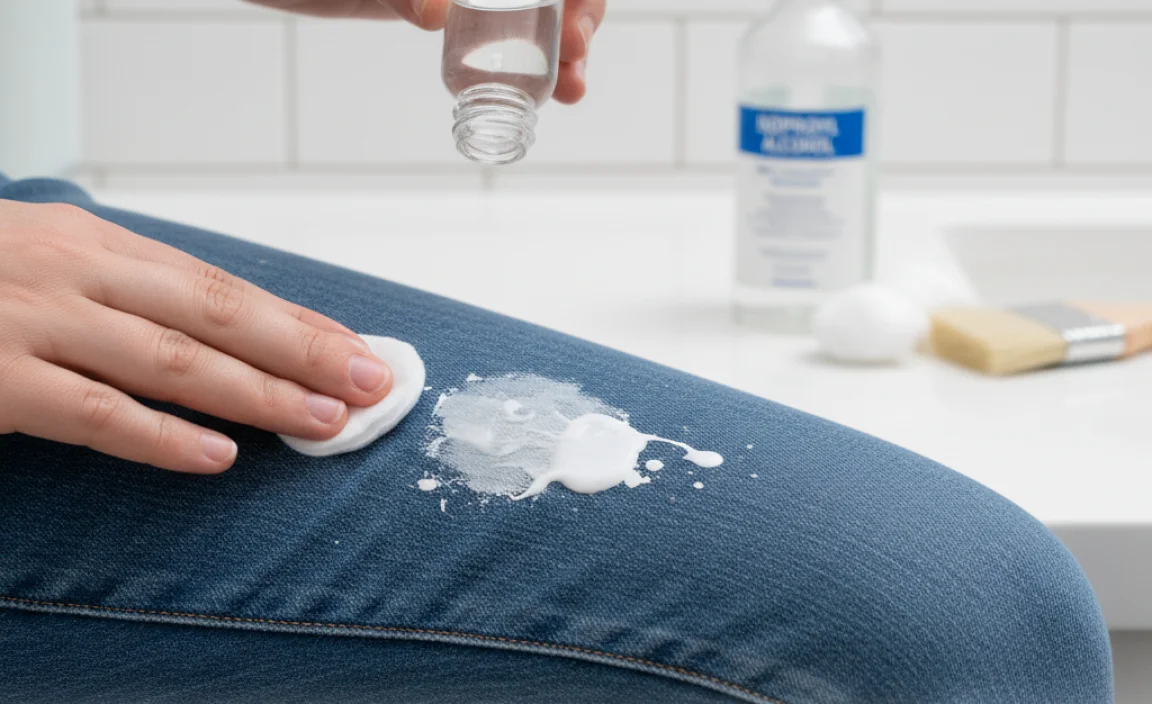
Rubbing alcohol is a fantastic solvent for acrylic paint. It’s readily available and generally safe for most denim. Always test in an inconspicuous area first to ensure it doesn’t affect the denim’s color.
Step-by-Step Guide:
- Prepare the Area: Lay the jeans flat on a protected surface (like an old towel or newspaper). Place a clean cloth or paper towel underneath the stained area to prevent it from bleeding through to the other side.
- Apply Rubbing Alcohol: Moisten a clean cloth or cotton ball with rubbing alcohol. Gently blot the painted area. You should see the paint start to lift onto the cloth. Keep dabbing, working from the outside of the stain towards the center, and switch to a clean part of the cloth or a new cotton ball as it picks up paint.
- Gentle Agitation: For slightly more stubborn paint, you can use an old toothbrush or a soft scrub brush. Dip it in rubbing alcohol and gently scrub the painted spot. Be firm but don’t scrub so hard that you damage the denim fibers.
- Rinse Thoroughly: Once most of the paint appears to be gone under the alcohol treatment, rinse the area thoroughly with cold water.
- Apply Dish Soap: Apply a small amount of mild dish soap directly to the treated area. Gently work it into the fabric with your fingers or the soft brush.
- Wash as Usual: Launder the jeans according to their care label, using cold water.
- Air Dry and Inspect: Crucially, do NOT put the jeans in the dryer until you are absolutely sure the stain is gone. Heat from the dryer will set any remaining paint. Air dry them and inspect. If any residue remains, repeat the process.
Method 2: Dish Soap and Glycerine Soak (Good for Slightly Older Stains)
Glycerine can act as a softening agent for dried paint, making it easier to lift. Using it with dish soap provides a good cleaning combination.
Step-by-Step Guide:
- Prepare the Soak Mixture: In a small bowl, mix one part mild dish soap with two parts glycerine. Stir well. You can warm the mixture slightly by placing the bowl in a larger bowl of warm water, but don’t make it hot.
- Apply the Mixture: Sponge or brush the mixture onto the dried paint stain. Let it sit for at least 15-30 minutes to soften the paint. For older, tougher stains, you might need to let it soak for a couple of hours.
- Gently Scrape and Blot: Use a dull knife or spoon to gently scrape away softened paint. Then, use a clean cloth dampened with cold water to blot and lift the loosened paint.
- Rinse and Reapply (if needed): Rinse the area. If paint residue remains, reapply the glycerine/dish soap mixture and let it sit longer before repeating the scraping and blotting.
- Wash as Usual: Once the paint is removed, wash the jeans in cold water with your regular detergent.
- Air Dry and Inspect: Again, allow the jeans to air dry completely before checking. Repeat if necessary.
Method 3: Commercial Stain Removers (For Stubborn, Dried Stains)
When household items don’t quite cut it, a specialized stain remover designed for paint or tough residues can be highly effective. Always choose a product that is safe for denim.
Step-by-Step Guide:
- Read Product Instructions: Carefully read and follow the instructions on the stain remover label. Different products have varying application methods and waiting times.
- Test in an Inconspicuous Area: Before applying to the stain, test the remover on an inside seam or hem to ensure it doesn’t damage or discolor your jeans.
- Apply the Remover: Apply the stain remover directly to the paint stain according to its instructions. This might involve spraying, dabbing, or letting it sit.
- Let it Work: Allow the stain remover to penetrate the paint and fabric for the recommended time.
- Agitate Gently: Use an old toothbrush or soft cloth to gently work the stain remover into the painted area.
- Rinse and Wash: Rinse the treated area thoroughly with cold water. Then, wash the jeans as usual in cold water.
- Air Dry and Inspect: Allow the jeans to air dry and inspect them for any remaining paint. Repeat the process if needed.
Tackling Tougher, Dried Paint Stains: Tips and Tricks
Dried acrylic paint is the most challenging. Here’s how to increase your chances of success:
- Patience is Key: Dried paint requires more time and repeated treatments. Don’t get discouraged if it doesn’t come out on the first try.
- Soften First: For very hard, dried paint, you might need to soften it before applying a solvent. A good soak in warm water with a bit of laundry detergent or the glycerine/dish soap mixture can help. You can also try carefully applying a damp hot cloth to the area to loosen it. However, be cautious with heat as it can set some stains.
- Gentle Scraping: After softening, use a dull knife or plastic scraper to carefully lift as much of the dried paint as possible. Work slowly to avoid snagging the denim.
- Consider Specialized Products: If standard methods fail, look for paint removers specifically designed for fabric. Products containing acetone or lacquer thinner can be very effective, but use with extreme caution as they can also damage or discolor denim. Always test these potent solvents thoroughly in a hidden area first and ensure good ventilation. Resources like EPA guidelines on hazardous waste remind us to use such chemicals responsibly and with proper safety measures.
What NOT to Do When Removing Acrylic Paint from Jeans
To avoid making the situation worse, steer clear of these common mistakes:
- Never use hot water initially: Hot water can set acrylic paint, making it much harder to remove. Always start with cold water.
- Avoid the dryer until the stain is gone: Heat is the enemy of stain removal. The dryer will bake the paint into the fabric.
- Don’t rub aggressively: Scrubbing too hard can spread the stain and damage the denim fibers.
- Don’t use bleach unless absolutely necessary and with caution: Bleach can remove the color from your jeans. If you must use it, dilute it significantly and test it first. It’s generally not recommended for spot treatments of acrylic paint.
- Don’t ignore the care label: Always check your jeans’ care label for specific washing and treatment instructions, especially for dark denim or delicate fabrics.
Comparing Removal Methods
Here’s a quick look at the pros and cons of common methods:
| Method | Pros | Cons | Best For |
|---|---|---|---|
| Rubbing Alcohol | Readily available, effective on fresh/moderate stains, relatively safe for denim. | Can require repeated applications for tougher stains, may affect some dyes. | Fresh to moderately set stains. |
| Dish Soap & Glycerine | Gentle, helps soften dried paint, good for slightly older stains. | May not be strong enough for very old or deeply set paint. | Slightly older but not fully dried stains. |
| Commercial Stain Removers | Formulated for tough stains, can be very effective. | Can be harsher chemicals, require careful testing and application, cost involved. | Stubborn, dried, or old paint stains. |
| Acetone/Lacquer Thinner (Extreme Caution) | Powerful solvent, can break down very tough paint. | Risks significant damage or discoloration to denim, strong fumes, requires strict safety precautions. | Last resort for extremely stubborn, old, dried paint where garment replacement is preferable to stain. |
Frequently Asked Questions (FAQ)
Q1: How quickly do I need to treat acrylic paint on my jeans?
A: The sooner, the better! Fresh acrylic paint is significantly easier to remove than dried paint. Act immediately to prevent it from setting into the fabric fibers.
Q2: Will rubbing alcohol damage my jeans?
A: Rubbing alcohol is generally safe for most denim. However, it’s always wise to test it on an inconspicuous area, like an inner seam, first to ensure it doesn’t affect the dye color.
Q3: Can I use nail polish remover?
A: Some nail polish removers contain acetone, which can act as a solvent. However, acetone can also be harsh and may discolor or damage denim. If you choose to try it, test it on a hidden spot first and use it sparingly, similar to how you would use a potent commercial remover.
Q4: What if the paint has been there for days and is completely dry?
A: Dried acrylic paint is tougher but often removable. Start by gently softening the paint with a glycerine and dish soap soak or a damp cloth. Then, you may need to try a commercial stain remover or, as a last resort and with extreme caution, a solvent like acetone after thorough testing.
Q5: Should I put my jeans in the washing machine right away?
A: You can wash them after you’ve treated the stain and believe it’s gone. However, never put them in the dryer until you are absolutely certain all traces of the paint stain have been removed. Otherwise, the heat will set the stain permanently.
Q6: Are there any professional services that can remove paint stains?
A: Yes, professional dry cleaners with experience in stain removal may be able to help, especially with very old or large paint stains. However, success is not guaranteed, and it can be costly. It’s usually best to attempt removal yourself first, especially on newer stains.
Conclusion: Your Jeans Are Probably Salvageable!
Accidents happen, but a little acrylic paint on your jeans doesn’t have to mean the end of a favorite garment. By understanding how acrylic paint works on fabric and by employing the right techniques—starting with immediate action for fresh spills and progressing to more targeted treatments for dried stains—you stand a very good chance of restoring your denim. Remember to always be patient, test any cleaning agents on a hidden area first, and resist the temptation to use heat until the stain is completely gone. With these proven methods, you can confidently tackle paint mishaps and keep your jeans looking their best.


